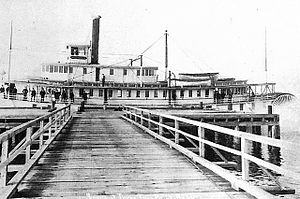- Multnomah (sternwheeler)
-

Multnomah at dock at Three Tree Point, circa 1910Career Name: Multnomah Port of registry:  United States
United StatesLaunched: 1885 In service: 1885-1911 Fate: Sunk following collision, 1911 General characteristics Type: sternwheel passenger/freight/towboat Length: 143 ft (43.6 m) The sternwheeler Multnomah was built at East Portland, Oregon in 1885 and operated on the Willamette and Columbia Rivers until 1889 in the United States. She was later transferred to Puget Sound and became one of the better known steamboats operating there.
Contents
Construction and Early Operations
She was built for the run from Portland to Oregon City and was considered one of the top boats on the Willamette River at the time.[1] One of her early captains was James D. Miller (1830–1914).[2]
Transfer to Puget Sound
In 1889, Multnomah was transferred to Puget Sound, where under the ownership of the S. Willey Navigation Company she made regular runs from Olympia to points on Puget Sound.[2]. In 1900, Captain H.H. McDonald (1857–1924)[2], who had already been operating the sternwheelers Three Tree Point and Johnson’s Landing on Anderson Island.[3]
Other captains for the Olympia-Tacoma Navigation Company included George L. Hill, who was in command on November 10, 1904 when Multnomah collided with the French full-rigged ship Amiral Cecile in Commencement Bay. In foggy conditions, the steamboat passed under the bowsprit of the ship, and the ship’s anchor flukes caught in the steamer’s upper works, tearing them up. Litigation went on for eight years over this, amid apparently credible charges that witnesses had been paid off.[2]
In 1907, Multnomah was converted from wood to oil-fired boilers. Almost all the boats built after 1905 were oil-fired, and they had improved locomotive-style boilers which lessened the chances of explosion.[1] The Olympia-Tacoma Navigation Company kept both Multnomah and Greyhound on the Tacoma-Olympia run until 1911, when they were replaced with the new express propeller steamer Nisqually. Even then, bus lines (called then the “auto stage”) were starting to compete with the steamboats.[1] At some point she was assigned work as a towboat.[4]
Collision and sinking
Multnomah met her end on October 28, 1911, when in a dense fog in Elliott Bay, she was rammed by the steamer Iroquois, sinking in 240 feet of water.[2]
Notes
- ^ a b c d e Newell, Gordon R., Ships of the Inland Sea, at 120-21, 131, 148, 165, Binford and Mort, Portland, OR (2nd Ed. 1960)
- ^ a b c d e f g Newell, Gordon R., ed., H.W. McCurdy Marine History of the Pacific Northwest, at 57, 88, 101, 197, 214, 233, 249, 358, Superior Publishing, Seattle, WA 1966 ISBN 0-87564-220-9
- ^ Galentine, Elizabeth, Anderson Island, at 50, Arcadia Publishing 2007 ISBN 0-7385-4854-5
- ^ Weinstein, Robert A., Tall Ships on Puget Sound – The Marine Photographs of Wilhelm Hester, at page 85, University of Washington Press, Seattle, WA 1978 ISBN 0-295-95619-4 (showing photo of Multnomah acting as tug for schooner Endeavor)
External links
Historic photographs from on-line collections of University of Washington
Website
Steamboats of Oregon and the Columbia River basin Coastal vessels - General Miles
- Life-Line
- T.M. Richardson
- Washington
Vessel lists Modern ferries - Wahkiakum County Ferry
- Needles-Fauquier Ferry (Arrow Lakes)
Steamboat lines Steamboat owners and captains - John C. Ainsworth
- John Bonser
- John H. Couch
- Joseph Kellogg
- James W. Troup
- Henry Villard
Builders and shipyards Shipwrecks British Columbia- Upper Fraser River
- Lakes Route
- Arrow Lakes
- Okanagan Lake
- Upper Columbia and Kootenay Rivers
- Skeena River
- Stikine River
- Peace River
Alaska and YukonOtherNavboxes - Puget Sound
- British Columbia
- Oregon Coast
- California
Lists of vessels - Ships in British Columbia
- Retired BC ferries
- Royal Navy ships in the Pacific Northwest
- Steamboats on the Columbia River
- Puget Sound steamboats
Puget Sound sternwheelers Categories:- History of Washington (state)
- Paddle steamers of Oregon
- Steamboats of the Columbia River
- Maritime incidents in 1911
- Steamboats of Washington (state)
- Ships built in Oregon
- 1885 ships
Wikimedia Foundation. 2010.



